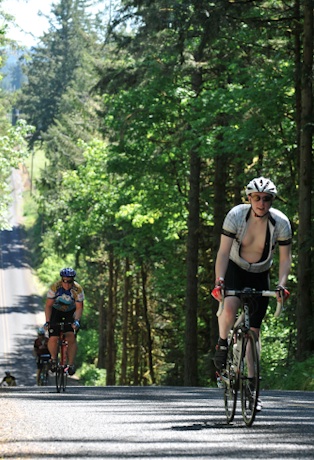
(Photo © J. Maus)
The beauty of a bicycle is that by its very design it lends itself to connecting its operator with other people, be it another person on a bike or anyone else nearby. The technology itself encourages social interaction.
I hope it was with this understanding about bicycles and human nature that led to the creation of the law allowing bicyclists to ride two abreast (but more likely it’s the bicycle’s relatively small physical footprint).
The problem, of course, is that bicycles are playing in an arena with a technology (automobiles) that by its very design discourages social interaction outside of itself. In many ways, these two technologies couldn’t be more different on their social impact: Bicycles naturally lend themselves to social interactions while motor vehicles to social isolation — it’s a rub that causes a tremendous amount of friction on multiple fronts, including livability, urban design, and even traffic law.
Bicycles defined as vehicles (which is the case in Oregon) makes for a kind of dissonance for anyone familiar with riding one. The law, in many instances, mandates bicycles be operated in a manner that minimizes their potential as mobile social hubs. It’s analogous to passing laws requiring all pedestrians to walk single file on a sidewalk.

Of course, the purpose of the law requiring people to ride no more than two abreast is to ensure the safe and unimpeded flow of both bicycle and motor vehicle traffic; but it’s a compromise law that satisfies neither type of user.
Here’s what the law actually says:
814.430 Improper use of lanes; exceptions; penalty.
(1) A person commits the offense of improper use of lanes by a bicycle if the person is operating a bicycle on a roadway at less than the normal speed of traffic using the roadway at that time and place under the existing conditions and the person does not ride as close as practicable to the right curb or edge of the roadway….
(e) When operating a bicycle alongside not more than one other bicycle as long as the bicycles are both being operated within a single lane and in a manner that does not impede the normal and reasonable movement of traffic.
People riding bicycles have the legal right to ride two abreast as long as:
- they are riding within one lane of traffic.
- motor vehicles approaching from the rear are able to pass safely while sharing the same lane.*
- after riding two abreast, they must return to single file, moving to the far side of the roadway as is safe, once one or more vehicles stack up behind them.
- (*It’s controversial whether “impede the normal and reasonable movement of traffic” is referring to a motor vehicle operator’s ability to pass within the lane shared with the person on a bike or having to move outside the lane to pass. This section of the ORS seems to imply that it is the shared lane where the impeding takes place, not the entirety of the highway.)
Whether the exception — when the lane is so narrow that a car and a bike are not able to safely share it — means that bicycle operators are within their right to continue to ride two abreast until the lane widens, is a great question and open for debate. Fortunately, PBOT’s general direction is to give people more room. Their new standard for bike lane width is six feet, a size that is specifically formulated to allow for two bicycles to ride side-by-side. And their growing network of bike boulevards also give bike traffic plenty of room.
But like always, regardless of the law, the endgame remains the same: be considerate of other road users and treat them as you would like to be treated.
— Bike Law 101 appears twice a month thanks to the generous support of West End Bikes PDX (corner of 11th and SW Stark in downtown Portland). It’s written by Karen Lally and Kurt Jansen of the non-profit Animated Traffic Law Center based in Eugene, Oregon. For more info on bike law, browse the Bike Law 101 archives

